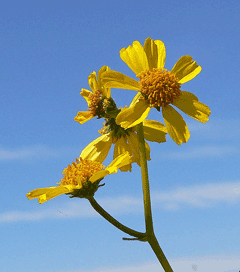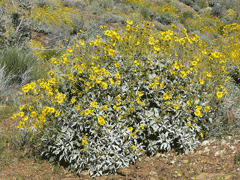 |
|
http://commons.wikimedia.org/wiki/User:Stan_Shebs |
 |
| http://commons.wikimedia.org/wiki/User:Stan_Shebs |
Translate this page:
Summary
Bloom Color: Yellow. Main Bloom Time: Early spring, Late spring, Late winter, Mid spring. Form: Irregular or sprawling, Rounded.
Physical Characteristics

 Encelia farinosa is a deciduous Shrub growing to 0.8 m (2ft 7in) at a medium rate.
Encelia farinosa is a deciduous Shrub growing to 0.8 m (2ft 7in) at a medium rate.
See above for USDA hardiness. It is hardy to UK zone 8 and is frost tender. It is in flower in May. The species is hermaphrodite (has both male and female organs) and is pollinated by Insects.
Suitable for: light (sandy) and medium (loamy) soils and prefers well-drained soil. Suitable pH: mildly acid, neutral and basic (mildly alkaline) soils. It cannot grow in the shade. It prefers dry or moist soil and can tolerate drought.
UK Hardiness Map
US Hardiness Map
Synonyms
Plant Habitats
Woodland Garden Sunny Edge; Cultivated Beds;
Edible Uses
Edible Parts:
Edible Uses: Gum
A gum that exudes from the ends of mature stems is used for chewing[61, 161, 177]. It is aromatic[207].
References More on Edible Uses
Medicinal Uses
Plants For A Future can not take any responsibility for any adverse effects from the use of plants. Always seek advice from a professional before using a plant medicinally.
Analgesic Odontalgic
A decoction of the blossoms, leaves and stems has been held in the mouth to alleviate a toothache[257]. A poultice of the plant has been used to alleviate pain[257].
References More on Medicinal Uses
The Bookshop: Edible Plant Books
Our Latest books on Perennial Plants For Food Forests and Permaculture Gardens in paperback or digital formats.

Edible Tropical Plants
Food Forest Plants for Hotter Conditions: 250+ Plants For Tropical Food Forests & Permaculture Gardens.
More

Edible Temperate Plants
Plants for Your Food Forest: 500 Plants for Temperate Food Forests & Permaculture Gardens.
More

More Books
PFAF have eight books available in paperback and digital formats. Browse the shop for more information.
Shop Now
Other Uses
Adhesive Fuel Gum Incense Resin Varnish Waterproofing
A resin that exudes from the ends of mature stems is used as a glue and as an incense in the home and in church[61, 177, 181, 207, 257]. It has also been used to waterproof containers and has been melted then used as a varnish[257]. The resinous branches have been used to make a quick fire[257].
Special Uses
References More on Other Uses
Cultivation details
Landscape Uses:Border, Erosion control, Ground cover, Massing, Specimen. Requires a very warm sunny position in a deep very well-drained soil[200, 260]. Plants strongly resent wet conditions, especially in the winter[200]. This species is not hardy in the colder areas of the country, it tolerates temperatures down to between -5 and -10°c[200]. Another report says that the plants will tolerate temperatures down to -12°c if they are in quite dry conditions[260]. The young growth in spring, even on mature plants, is frost-tender and so it is best to grow the plants in a position sheltered from the early morning sun[K]. Plants have a taproot and resent root disturbance[200]. They should be planted out into their permanent positions whilst still small, though they will then need protection from the cold for their first winter or so[K]. Special Features:
North American native, Fragrant foliage, Blooms are very showy.
References Carbon Farming Information and Carbon Sequestration Information
Temperature Converter
Type a value in the Celsius field to convert the value to Fahrenheit:
Fahrenheit:
The PFAF Bookshop
Plants For A Future have a number of books available in paperback and digital form. Book titles include Edible Plants, Edible Perennials, Edible Trees,Edible Shrubs, Woodland Gardening, and Temperate Food Forest Plants. Our new book is Food Forest Plants For Hotter Conditions (Tropical and Sub-Tropical).
Shop Now
Plant Propagation
Seed - sow spring in a greenhouse. Only just cover the seed and pot up the seedlings into individual pots as soon as they are large enough to handle[200]. Grow on in a greenhouse for at least their first winter, making sure the pots are deep enough to accommodate the tap root, and plant out in early summer. Cuttings, in pure sand, in a frame[200]. The report does not specify the type of cutting.
Other Names
If available other names are mentioned here
Native Range
NORTHERN AMERICA: United States (Arizona, California (south), Nevada (south), Utah (Washington Co.)), Mexico (Baja California (Norte), Baja California Sur, Sinaloa, Sonora)
Weed Potential
Right plant wrong place. We are currently updating this section.
Please note that a plant may be invasive in one area but may not in your area so it's worth checking.
Conservation Status
IUCN Red List of Threatened Plants Status :

Growth: S = slow M = medium F = fast. Soil: L = light (sandy) M = medium H = heavy (clay). pH: A = acid N = neutral B = basic (alkaline). Shade: F = full shade S = semi-shade N = no shade. Moisture: D = dry M = Moist We = wet Wa = water.
Now available:
Food Forest Plants for Mediterranean Conditions
350+ Perennial Plants For Mediterranean and Drier Food Forests and Permaculture Gardens.
[Paperback and eBook]
This is the third in Plants For A Future's series of plant guides for food forests tailored to
specific climate zones. Following volumes on temperate and tropical ecosystems, this book focuses
on species suited to Mediterranean conditions—regions with hot, dry summers and cool, wet winters,
often facing the added challenge of climate change.
Read More
Expert comment
Author
Gray.
Botanical References
71200
Links / References
For a list of references used on this page please go here
Readers comment
| Add a comment |
|
If you have important information about this plant that may help other users please add a comment or link below. Only comments or links that are felt to be directly relevant to a plant will be included. If you think a comment/link or information contained on this page is inaccurate or misleading we would welcome your feedback at [email protected]. If you have questions about a plant please use the Forum on this website as we do not have the resources to answer questions ourselves.
* Please note: the comments by website users are not necessarily those held by PFAF and may give misleading or inaccurate information.
To leave a comment please Register or login here All comments need to be approved so will not appear immediately.
|
Subject : Encelia farinosa
|
|
|
|